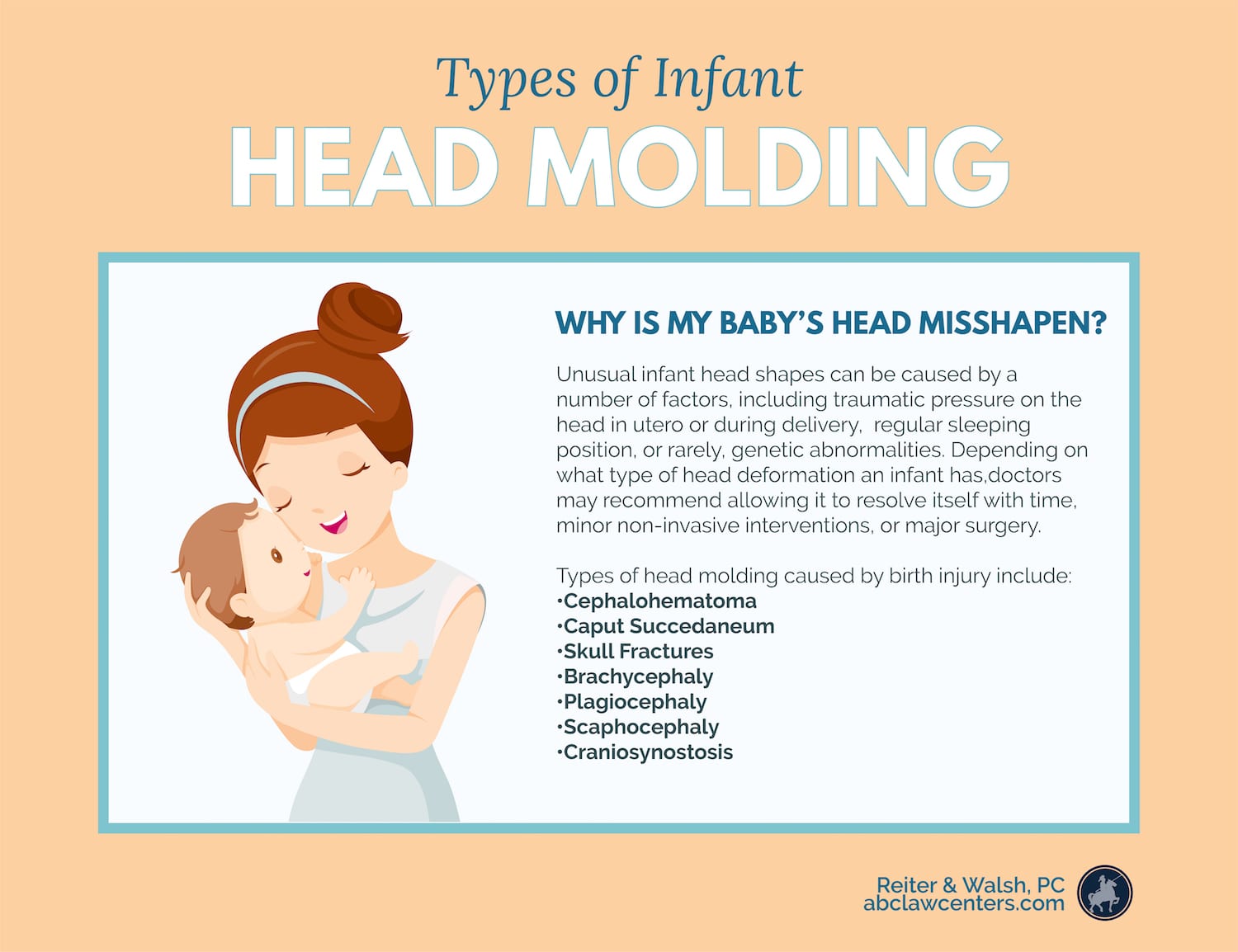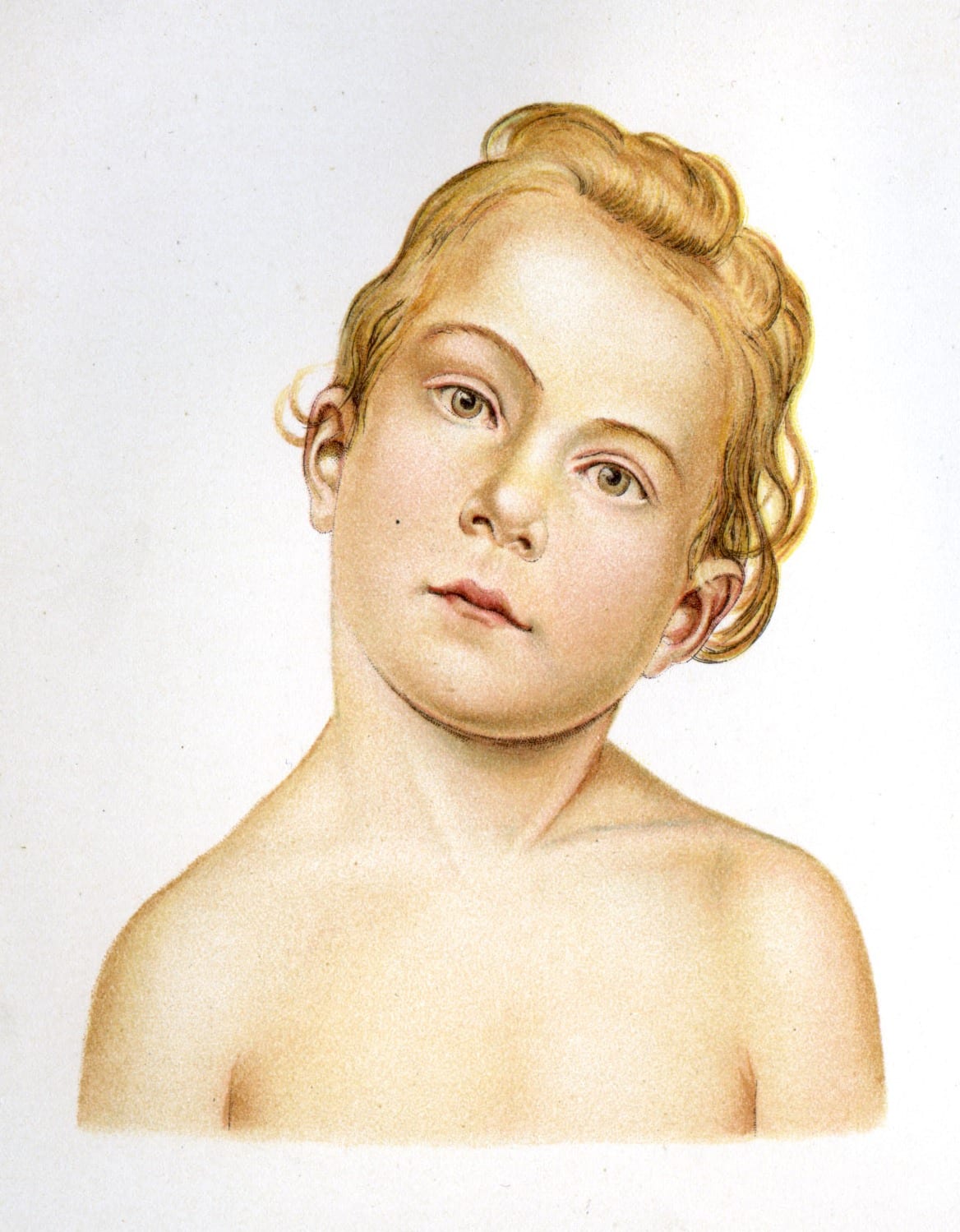Why does my baby’s head look misshapen?
Unusual infant head shapes can be caused by a number of factors, including traumatic pressure on the head in utero or during delivery, regular sleeping position, or rarely, genetic abnormalities. Depending on what type of head deformation an infant has, doctors may recommend allowing it to resolve itself with time, minor non-invasive interventions, or major surgery. Throughout this page, we’ll review some of the more common causes of misshapen heads in babies.

Background Information on Infant Skull Development
A baby’s skull consists of overlapping bone plates, connected by junctions called sutures. New bone emerges from the suture lines, allowing a baby’s head to grow symmetrically. Normally, the sutures close between 2-3 years of age. This allows the skull to expand and accommodate a growing brain. Before suture closure, newborn skulls are very soft and malleable.
The Effect of Traumatic Pressure
Because of the flexibility of infant’s heads, pressure on one or more parts of the skull can cause it to take on an abnormal shape. This is referred to as deformational molding. Deformational molding can occur in utero, during labor and delivery, or in early infancy.
Deformational Molding in Utero or During Birth: Risk Factors
If an infant’s head is pressed upon in utero or during the birthing process, this can lead to deformational molding. Some pregnancy and birth-related factors that can contribute to deformational molding include:
- Cephalopelvic disproportion (CPD): When an infant’s head is too large to fit through the mother’s pelvis.
- Oligohydramnios: Insufficient levels of amniotic fluid
- Twins/multiple births
- Prolonged or arrested labor
- Breech birth
Physicians are supposed to pay close attention to the health and well-being of the baby during prenatal tests and delivery. If there are signs of any of the above conditions, some form of medical intervention (such as an emergency C-section) may be necessary. Failure to diagnose and act quickly increases the infant’s chances of experiencing severe head trauma during vaginal delivery. It is also important to note that cerebral compression injuries can have catastrophic consequences without external signs of damage. These consequences can include seizures, fetal stroke, or intracranial hemorrhages.
Types of Head Molding Caused By Birth Injuries
There are several types of head molding that can occur as a result of birth injury in late pregnancy or during labor and delivery. Here are a few examples:
Cephalo- means “head” or “skull,” and a hematoma is a blood clot that occurs outside of a blood vessel. A cephalohematoma is a clot that occurs in the area between the skull and the periosteum (the membrane that covers the skull) as a result of ruptured blood vessels. Infant cephalohematomas are associated with the use of birth-assisting tools like forceps or vacuum extractors or prolonged or traumatic labors. Usually, a cephalohematoma will manifest as a raised solid bump on a baby’s head. It appears several hours to a day after birth and is often largest on the second or third day. Infant cephalohematomas usually heal without any major medical intervention, but if improperly treated, the consequences can be more serious.
A caput succedaneum is a swelling in the skin and tissues surrounding the skull. It most often forms after a difficult delivery. It can often be the result of vacuum extraction or premature rupture of membranes. Symptoms include scalp swelling and bruising, usually on the part of the head that presents first. Sometimes this can give an infant a “conehead” appearance. If bruising is involved, the infant may also develop jaundice. Generally, the caput succedaneum goes away without intervention within a few days.
Skull Fractures
Infant skulls are also susceptible to fractures. Sometimes they appear as crater-like indentations and can be called “ping-pong” fractures because the size and shape resembles half of a ping-pong ball. These can be caused by difficult labor or a lack of space in utero. Depending on the severity, ping-pong fractures may require surgical correction. They are also associated with other complications such as hematomas.
Positional Molding in Early Infancy
In order to avoid Sudden Infant Death Syndrome (SIDS), the American Academy of Pediatrics recommends that infants be positioned on their backs for sleeping. While this is a very important safety measure, having babies spend too much time with one part of their head pressed against a surface – even something soft like a bed or a car seat – can cause that part of their skull to flatten. Exactly what shape the skull takes on depends on their most common sleeping position.
Brachycephaly
The change in skull shape may not be very noticeable in infants who tend to lie with their faces pointed toward the ceiling, because their hair might cover the flat spot on the back of their heads. This type of positional molding is referred to as brachycephaly.

Some infants, when placed on their backs, have a tendency to turn their heads a bit to one side or the other. Infants who have torticollis are especially prone to this. Torticollis is a condition that can emerge as a result of a difficult pregnancy or delivery. Infants with torticollis hold their heads at an angle due to asymmetrical stretching of neck muscles; if they do this while sleeping, it can result in a type of positional molding called plagiocephaly. Infants with plagiocephaly have a more asymmetric face shape.
Scaphocephaly
Infants who always lie on their sides (which is generally not recommended because this is considered a risk factor for SIDS) tend to develop long, narrow heads. This condition is called scaphocephaly, or sometimes dolichocephaly.
To prevent or treat positional molding, you can rotate your baby’s head from side to side throughout the night (while still ensuring that they lie on their back to prevent SIDS). This can sometimes be accomplished by changing the direction in which the baby lies in the crib, or the location of the crib so that they are encouraged to look in a different direction as they are falling asleep. When awake and under close supervision, infants can also spend time on their stomachs. If positional molding is not resolved after an infant is four to eight weeks old, your doctor may recommend that they wear a cranial molding helmet. Cranial molding helmets are soft and designed to reduce excessive growth in bulging areas while allowing it in flattened areas. They need to be adjusted as babies grow. Usually, the helmets are worn for 3-6 months.
In most cases, positional molding is largely a cosmetic concern and easily reversible, but it is important to know that similarly misshapen heads can be a sign of a more serious condition: craniosynostosis.
Craniosynostosis
Craniosynostosis is a condition in which one or more of the skull sutures close prematurely. In some cases, the skull may begin to push on the brain and hinder cognitive development. Craniosynostosis can be caused by pressure on the skull while in utero, or by genetic factors.
Although there are certain indications that an infant has craniosynostosis rather than positional molding, such as the lack of a ‘soft spot,’ the presence of a raised ridge along sutures, or a lack of head growth, the difference is not always easy to recognize. To diagnose craniosynostosis, your doctor may order an x-ray or CT scan. Treatment for craniosynostosis generally involves surgery to relieve pressure on the brain, allow for future brain growth, and improve physical appearance. If surgically corrected in a timely manner, the prognosis is often good. However, if left untreated, craniosynostosis can lead to seizures and developmental delays.
Note: Some of the terminology used when discussing positional molding, such as brachycephaly, plagiocephaly, and scaphocephaly, can also be used to describe types of craniosynostosis with similar outward appearances. If you are at all confused about what a medical professional is telling you, ask for a clarification.
The information presented above is intended only to be a general educational resource. It is not intended to be (and should not be interpreted as) medical advice. If you have questions about an infant with an unusual head shape, please consult with a medical professional.
About ABC Law Centers: Birth Injury Lawyers
ABC Law Centers: Birth Injury Lawyers was established to focus exclusively on birth injury cases. A “birth injury” is any type of harm to a baby that occurs just before, during, or after birth. This includes issues such as oxygen deprivation, infection, and trauma. While some children with birth injuries make a complete recovery, others develop disabilities such as cerebral palsy and epilepsy.
If a birth injury/subsequent disability could have been prevented with proper care, then it constitutes medical malpractice. Settlements from birth injury cases can cover the costs of lifelong treatment, care, and other crucial resources.
If you believe you may have a birth injury case for your child, please contact us today to learn more. We are happy to talk to you free of any obligation or charge. In fact, clients pay nothing throughout the entire legal process unless we win.
Free Case Review | Available 24/7 | No Fee Until We Win
Phone (toll-free): 888-419-2229
Press the Live Chat button on your browser
Complete Our Online Contact Form
Sources
- Craniosynostosis
- Caput succedaneum
- Depressed Skull Fracture in a Term Newborn Infant
- Misshapen Heads in Babies: Position or Pathology?
- Head Shape in Infants: Synostosis and Plagiocephaly
- Deformational Plagiocephaly
- Wong HW, Perry L. Maternal Child Nursing Care. 2006